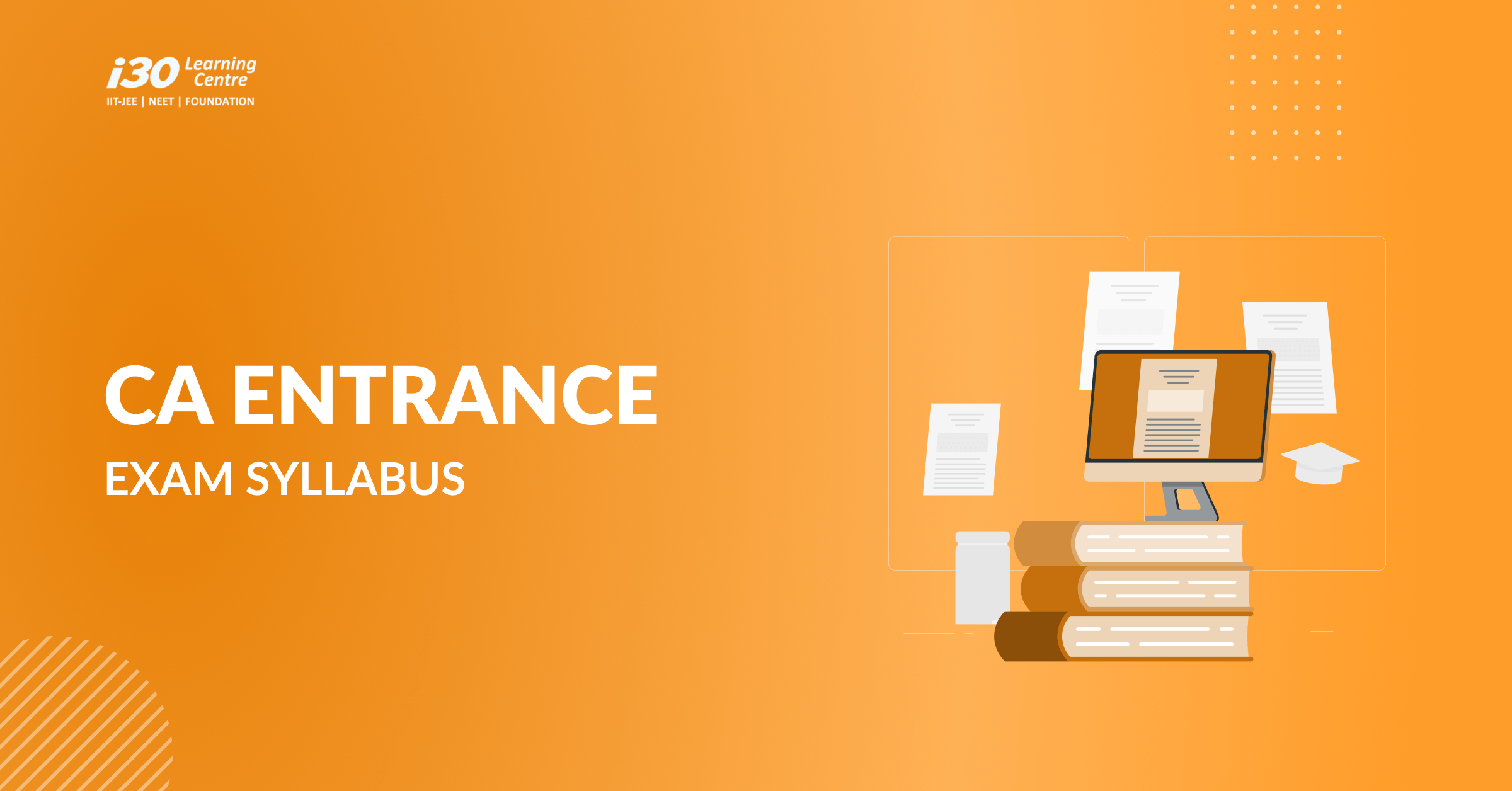CA Entrance Exam, also known as the CA Foundation, is the first exam in the CA course. After passing the 12th-grade examination, students are eligible to take the CA Foundation exam. For that, they need to get themselves registered, fill out the form, and pay the fees as mentioned by The Institute of Chartered Accountants of India (ICAI). The CA Entrance Exam syllabus, created by ICAI, includes all of the essential topics and contents that students must study to pass the exam. This exam is conducted twice a year.
The ICAI has already released the syllabus of the CA Foundation on their website for the 2023 examination and the same can be downloaded in pdf form. The ICAI recently announced the dates for the CA Foundation exam 2023, which will be conducted from June 23 to June 30, 2023.The application form for the exam will be available on February 3, 2023.
In this article, we will discuss the CA Foundation syllabus and the subjects.
Let’s go!
What Is the Syllabus for CA Foundation?
The candidate has to give four papers to clear the CA Foundation exam. The following are the four subjects:
- Principles and Practice of Accounting
- Business Laws and Business Correspondence and Reporting
- Business Mathematics, Logical Reasoning, and Statistics
- Business Economics and Business and Commercial Knowledge
The following is the syllabus for the CA Foundation course:
Paper-1: Principles and Practice of Accounting – The duration for Paper-1 is 3 hours
| S.no | Topics |
| 1 | Theoretical FrameworkMeaning and Scope of accounting concepts, Principles, and ConventionsAccounting terminology – GlossaryCapital and revenue expenditure, Capital and revenue receipts, Contingent assets, and contingent liabilities accounting PoliciesAccounting as a Measurement Discipline – Valuation Principles, Accounting EstimatesAccounting Standards – Concepts and ObjectivesIndian Accounting Standards- Concepts and Objectives |
| 2 | Accounting ProcessBooks of AccountsPreparation of Trial BalanceRectification of Errors |
| 3 | Bank Reconciliation StatementIntroduction, reasons, preparation of bank reconciliation statement |
| 4 | InventoriesCost of inventory, Net realizable value, Basis, and technique of inventory valuation and record keeping. |
| 5 | Concept and Accounting of DepreciationConcepts, Methods of computation, and accounting treatment of depreciation Change in depreciation methods. |
| 6 | Accounting for Special Transactions Bills of exchange and promissory noteMeaning of Bills of Exchange and Promissory Notes and their Accounting Treatment; Accommodation bills.Sale of goods on approval or return basis Meaning of goods sent on approval or return basis and accounting treatment. Consignments Meaning and Features of consignment business, Difference between sale and consignment, Accounting treatments for consignment transactions and events in the books of consignor and consignee. Average due Date Meaning, Calculation of average due date in various situations. Account Current Meaning of Account Current, Methods of preparing Account Current |
| 7 | Final Accounts of Sole ProprietorsElements of financial statements, Closing Adjustment Entries, Trading accounts, Profit and Loss Accounts,s and Balance Sheets of Manufacturing and Non-manufacturing entities. |
| 8 | Partnership Accounts Final Accounts of Partnership Firms Admission, Retirement and Death of a Partner including Treatment of Goodwill Introduction to LLPs and Distinction of LLPs from Partnership. |
| 9 | Financial Statements of Not-for-Profit OrganizationsSignificance of Receipt and Payment Account, Income and Expenditure Account and Balance Sheet, Difference between Profit and Loss Account and Income and Expenditure Account. Preparation of Receipt and Payment Account, Income and Expenditure Account, and Balance Sheet. |
| 10 | Introduction to Company AccountsDefinition of shares and debentures Issue of shares and debentures, forfeiture of shares, re-issue of forfeited shares Statement of Profit and Loss and Balance Sheet as per Schedule III to the Companies Act, 2013. |
Paper-2: Business Laws and Business Correspondence and Reporting (Duration: 3 hours; 100 marks)
The paper-2 is divided into the following section:
SECTION A: BUSINESS LAWS (60 Marks)
| S.no | Topics |
| 1. | The Indian Contract Act, 1872An overview of Sections 1 to 75 covering the general nature of the contract, consideration, other essential elements of a valid contract, performance of a contract, breach of contract, Contingent and Quasi Contract. |
| 2. | The Sale of Goods Act, 1930Formation of the contract of sale, Conditions and Warranties, Transfer of ownership and delivery of goods, Unpaid seller and his rights. |
| 3. | The Indian Partnership Act, 1932General Nature of Partnership, Rights, and duties of partners, Reconstitution of firms, Registration and dissolution of a firm |
| 4. | The Limited Liability Partnership Act, 2008Introduction- Nature and scope, Essential features, characteristics of LLP, Incorporation and differences with other forms of organizations. |
| 5. | The Companies Act, 2013Essential features of the company, corporate veil theory, Classes of companies, types of share capital, Incorporation of company, Memorandum of Association, Articles of Association, Doctrine of Indoor Management |
.
SECTION B: BUSINESS CORRESPONDENCE AND REPORTING (40 Marks)
| S.no | Topics |
| 1. | CommunicationTypes Directions NetworkProcessProblemsBarriersTypes of Communication a) Interpersonal Skills b) Listening Skills c) Emotional Intelligence Sample Questions with Answers Exercises. |
| 2. | Sentence Types (Direct-Indirect, Active -Passive Speech) |
| 3. | Vocabulary Root Words, Synonyms, Antonyms, Prefixes, Suffixes), Phrasal verbs, Collocations and Idioms. |
| 4. | Comprehension Passages |
| 5. | Note Making |
| 6. | Introduction to Basic Writing |
| 7. | Précis Writing |
| 8. | Article Writing |
| 9. | Report Writing |
| 10. | Writing Formal Letters |
| 11. | Writing Formal Mails |
| 12. | Resume Writing |
| 13. | Meetings |
Paper-3: Business Mathematics, Logical Reasoning and Statistics – Duration is 3 hours (100 marks)
Part – A. Business Mathematics (40 Marks)
| S.no | Topics |
| 1. | Ratio and Proportion, Indices and Logarithms |
| 2. | Equations |
| 3. | Linear Inequalities with Objective Functions and Optimization w.r.t. objective function. |
| 4. | Time value of Money |
| 5. | Permutations and Combinations |
| 6. | Sequence and Series |
| 7. | Sets, Relations, and Functions |
| 8. | Basic applications of Differential and Integral calculus |
Part – B: Logical Reasoning (20 Marks)
| S.no | Topic |
| 1. | Number series, Coding and Decoding, and the odd man out |
| 2. | Direction Tests |
| 3. | Seating Arrangements |
| 4. | Blood Relations |
Part – C: Statistics (40 Marks)
| S.no | Topic |
| 1. | The statistical description of Data |
| 2. | Measures of Central tendency and Dispersion |
| 3. | Probability |
| 4. | Theoretical Distributions |
| 5. | Correlation and Regression |
| 6. | Index Numbers |
Paper-4: Business Economics and Business and Commercial Knowledge – Duration is 3 hours (100 marks)
PART I: BUSINESS ECONOMICS (60 Marks)
| S.no | Topics |
| 1. | Introduction to Business Economics |
| 2. | Theory of Demand and Supply |
| 3. | Theory of Production and Cost |
| 4. | Price Determination in Different Markets |
| 5. | Business Cycles |
PART – II: BUSINESS AND COMMERCIAL KNOWLEDGE (40 MARKS)
| S.no | Topics |
| 1. | Business and Commercial Knowledge – An Introduction |
| 2. | Business Environment |
| 3. | Business Organizations |
| 4. | Government Policies for Business Growth |
| 5. | Organizations Facilitating Business |
| 6. | Common Business Terminologies |
How Many Subjects Are in CA Foundation?
CA Foundation consists of six subjects that are worth 100 marks each, and the duration for each subject is 3 hours. Papers 1 and 2 are subjective in nature, whereas papers 3 and 4 are objective in nature.
The following are the subjects in CA Foundation:
- Principles and Practices of Accounting
- Business Laws and Business Correspondence and Reporting
- Business Mathematics and Logical Reasoning and Statistics
- Business Economics and Business and Commercial Knowledge
How to Download the CA Foundation Syllabus 2023 PDF?
The CA foundation syllabus is quite vast as it covers many topics, and the PDFof the syllabus is available on the official website of the ICAI.
The following are the steps to download the CA Foundation Syllabus 2023 PDF:
- Visit the ICAI website (www.icai.org)
- Then click on students present on the top bar, then click on BoS Knowledge Portal.
- You will be redirected to the homepage of the BoS Portal.
- Click on Click here to visit BoS Knowledge Portal.
- Scroll down and click on the syllabus.
- Then click on Foundation and then click on click here to download the pdf.
Are There Any Updates in the CA Foundation 2023 Syllabus?
Yes, currently the CA foundation examination consists of six subjects and four papers. The new scheme comprises only 4 papers and 4 subjects, as the 2 subjects namely, Business & Commercial Knowledge and Business Correspondence & Reporting, have been removed from the syllabus.
The following are the subjects proposed by ICAI:
- Accounting
- Business Laws
- Quantitative Aptitude (Business Mathematics, Logical Reasoning, and Statistics)
- Business Economics
FAQs: CA Entrance Exam Syllabus
Which is the toughest subject in CA Foundation?
Paper 3 of CA Foundation which consists of Business Mathematics, Logical Reasoning, and Statistics, is more difficult to pass as compared to other subjects in the exam.
Can we do CA without math?
Yes, you can pursue CA without math in 12th standard.
Is CA Foundation math easy?
No, business mathematics is the exam that the candidate has to give in their CA Foundation. The candidate needs to practice daily in order to get a good score.
Is CA Foundation exam easy?
CA Foundation is comparatively easier than the CA Intermediate exam and the CA Final exam, as it is the first level in CA Course.
Wrapping up
This was all about the CA foundation exam syllabus for the June 2023 attempt, which is just a few months away. Go thoroughly through the syllabus once again and start preparing for the examination. We hope you were able to find answers to your questions. If you have any queries, let us know in the comment section.
Also, do not forget to share this information with your friends and do subscribe to know more about CA exams.



